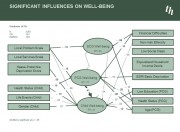Well-being and the Family System

Pratschke, J., Haase, T. and McKeown, K. (2011)
Presentation delivered at the Growing Up in Ireland Conference, Dublin, 1st December 2011
This study is based on a sophisticated statistical model of relationships within the “family system”. It shows that the most important influence on children’s well-being is whether their own mother enjoys a high level of well-being. For every unit increase in well-being amongst the primary caregiver (almost all of whom are the biological mother), children’s well-being increases by just under half a unit (0.41), even when controlling for a broad range of socio-economic, demographic and neighbourhood factors. Equally striking is the fact that after controlling for the influence of the mother, the secondary caregiver (typically the biological father) has no additional significant impact on the child’s well-being.
Child well-being is conceptualised, in this study, as involving positive emotional displays, an absence of behavioural problems and hyperactivity, getting on with other children, a sense of happiness and popularity, satisfaction with the child’s own appearance and intellectual abilities and his or her academic achievements. Parental well-being, by contrast, was conceptualised as involving an absence of depression, a satisfying intimate relationship and a positive orientation towards parenting.
Following the mother’s well-being, the next most important influences on child well-being were found to be the mother’s age (the older, the higher the child’s well-being), the child’s physical health and the deprivation score for the area of residence. Other factors include the child’s gender (boys have higher well-being than girls on average), the mother’s education, the child’s ethnicity (non-Irish children have lower well-being, again on average), neighbourhood problems, whether the child has experienced a traumatic event and the mother’s physical health. Almost one-third of the variability of well-being can be explained using the aforementioned factors, although this drops to 17% for mothers and just 4% for fathers.
One of the main policy-related conclusions of the research presented by Pratschke, Haase and McKeown relates to the ways in which parents (and mothers in particular) simultaneously “buffer” children against economic hardship and “mediate” the influence of the external environment via their own well-being and health. The authors aim to continue a strong research involvement in this area in the future by extending their analysis to specific kinds of families and using the repeated measures from the “Growing Up in Ireland” survey to shed light on the complex links between the well-being of different family members at different points in time.







